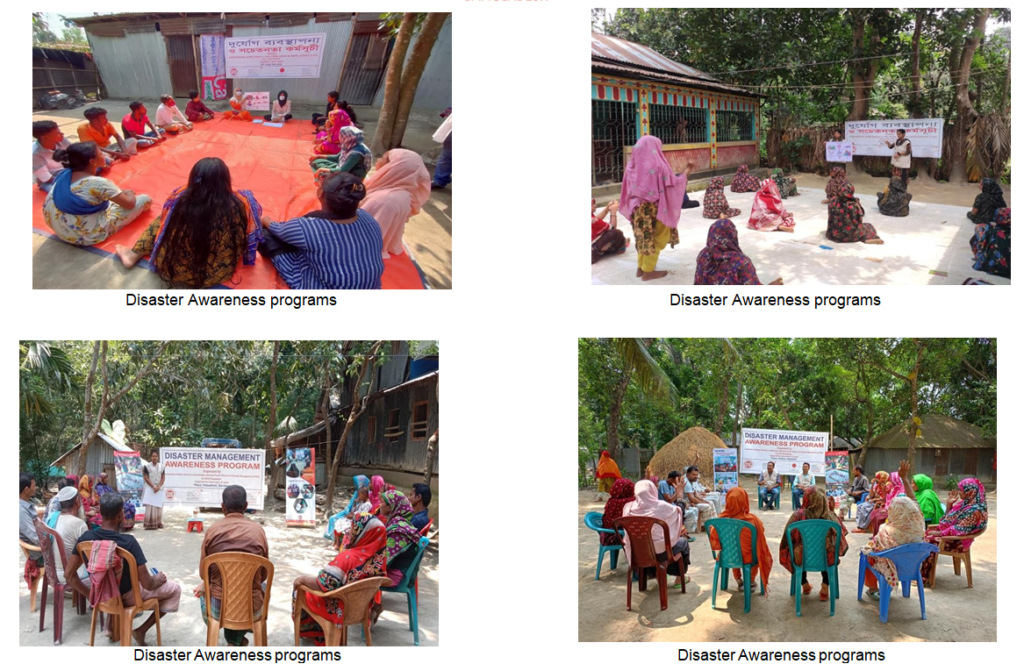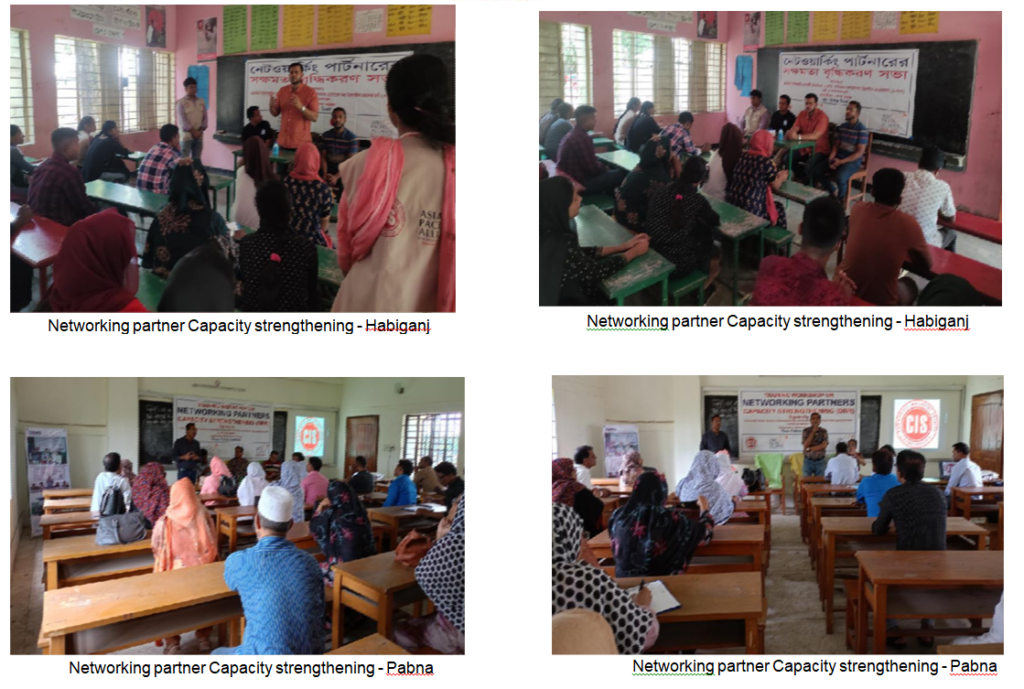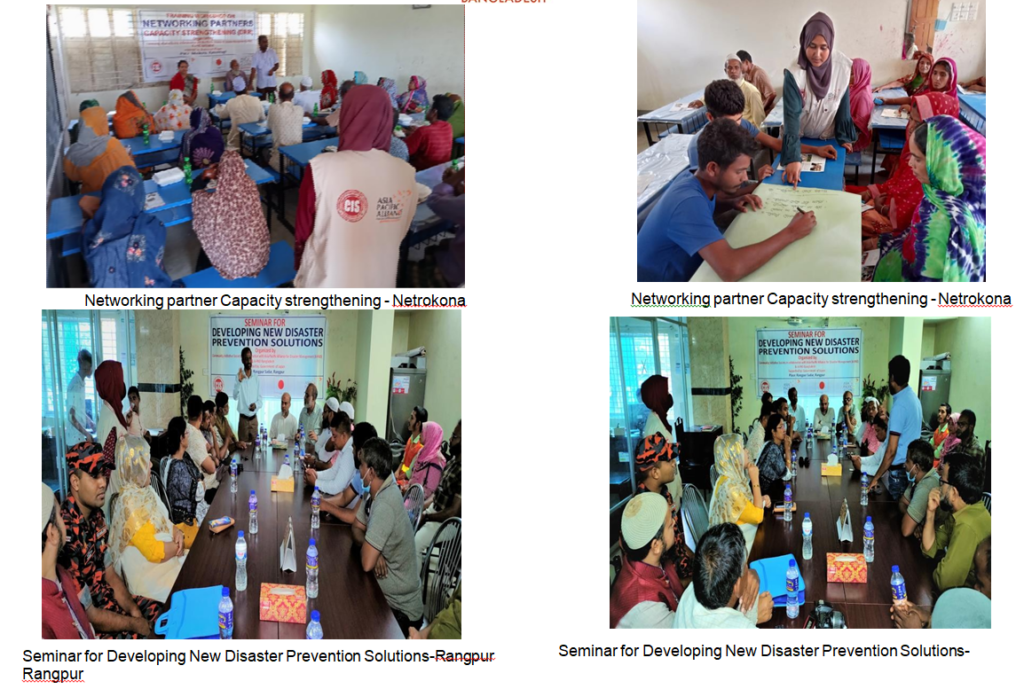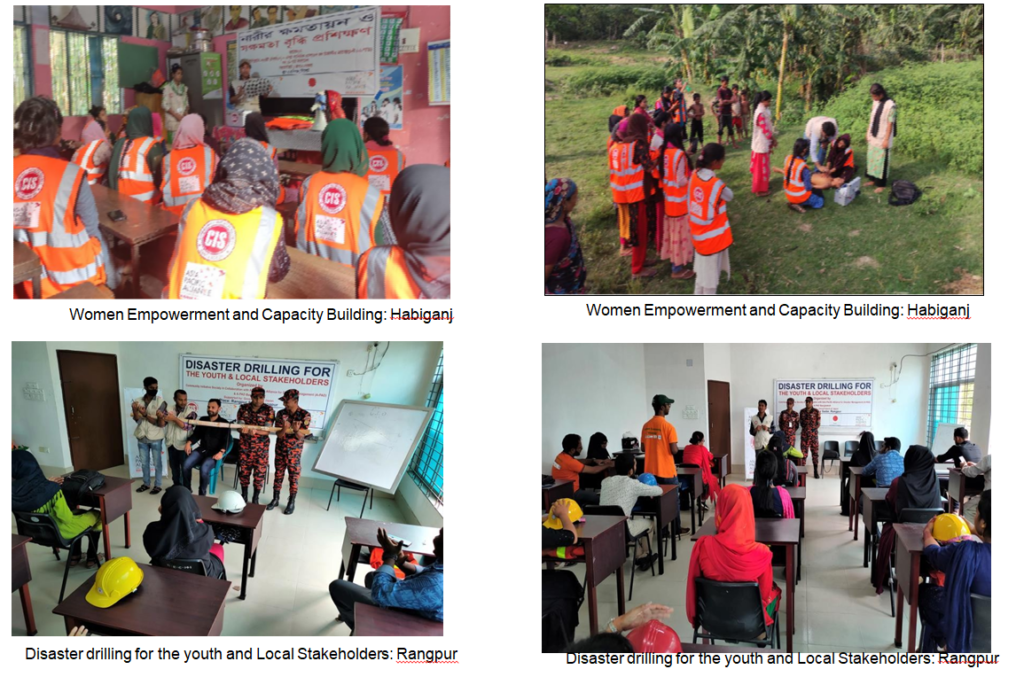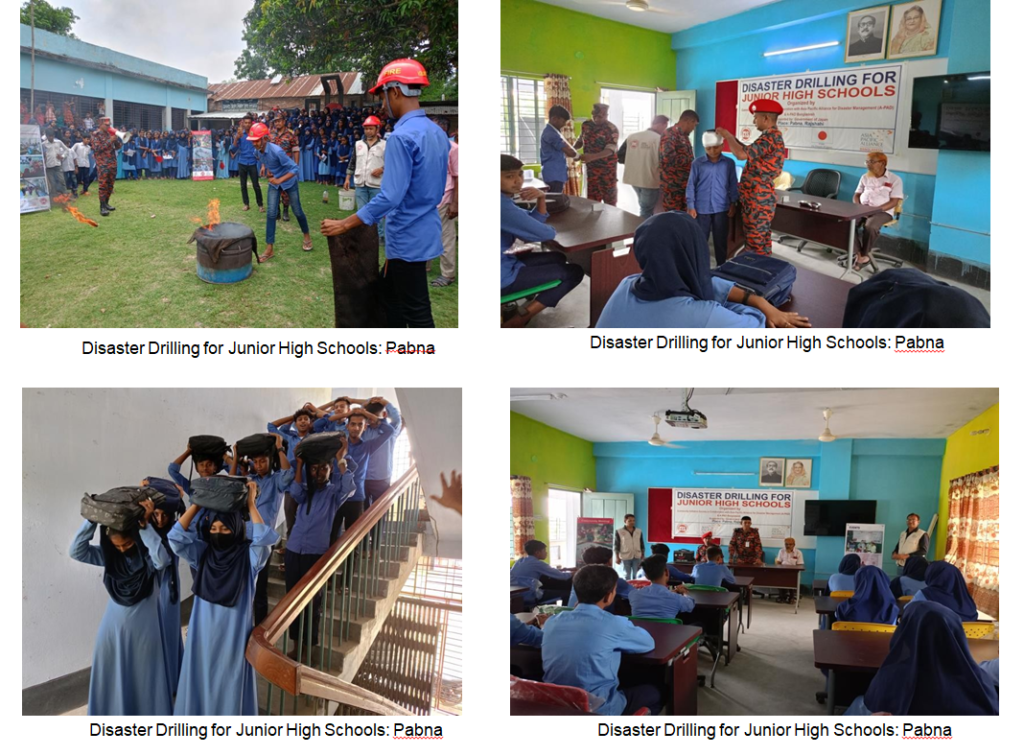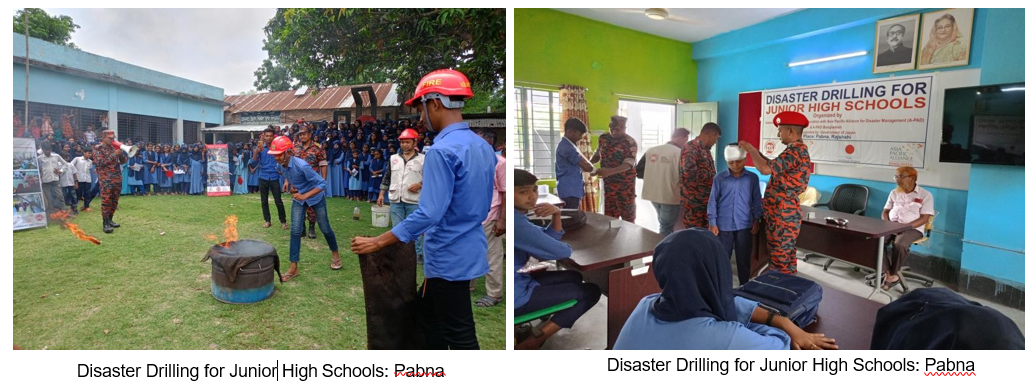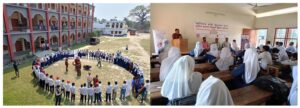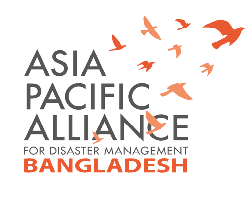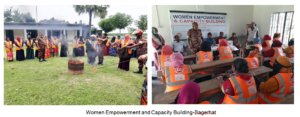A-PAD Bangladesh Activity Report Month of May 2023
Project Title: Strengthening Capacity for Sustainable Disaster Management Network by involving multi-sectoral platform Project Period: 17 January, 2023 – 16 January, 2024 (12 month)
- Project Activities and Accomplishments
Bangladesh is one of the most vulnerable countries to natural disasters and, due to climate change; we are facing natural disasters almost every year. Combined with the country’s geographical location, topography, and dense population, disaster events often result in high loss of life and economic loss, though Bangladesh has been successfully reducing the loss of human lives over the years. The frequency and intensity of natural disasters have been increased in recent years due t o climate change. The climatic events have serious consequences on broad agricultural sectors, food security, water, health and sanitation and leave serious impacts on life and livelihood of the communities. But so far we have limited disaster risk related data to understand the depth of household and population characteristics and loss sustained by the community at the household levels.
A-PAD Bangladesh started project from January 2023 and presently continue it 17 January 2023 to build up capacity on disaster management. It communicates with the different sectors like local community, community leaders, stakeholders, GOVT. officials continuing training on disaster management. To hold training program A-PAD Bangladesh staff organized small community meeting to sharing ideas on disaster and introduced them about A-PAD Bangladesh activity. A-PAD Bangladesh working 8 divisional areas.
There are 1 health workers in each divisions whose are doing home visit and aware the local community about basic disaster awareness. The health workers gave basic ideas about disaster management. A-PAD Bangladesh working at the rural areas. If there would be any directions or announcement from GOVT. or any disaster related news has been published the health workers delivered the message to the local community. Total 4,740 persons were benefited from A-PAD Bangladesh on May 2023.
A-PAD Bangladesh attended coordination meeting at the 8 divisions in Office of Deputy Commissioner. At that meeting different NGOs had joined and explained their activities. Besides this what will be the next activities of the GOVT. and NGOs were discussed at that meeting.
1. To manage the emergency disaster management coordination centers in disaster-prone areas (Outcome 1) The disaster management coordination center in disaster vulnerable areas established in this project (3 year project) functions as a disaster response base in each region, and contributes for preventing the spread of health damage to local residents and community-led disaster risk reduction measures. | ||
Activities | Outcome Indicators to Measure Results: | Project Status: Achievements vs Outcome: If the activity is behind the schedule, please write the reason. |
1-1 Operation of Emergency Disaster Management Coordination Centers Beneficiaries: 10 people x 25 days x 8 divisions x 12 months = 24,000 people 50 people x 8 campaign x 12 months = 4,800 people | 【Indicators of Outcome】 1-1: The disaster response management centers in 8 places (Dhaka, Chattagram, Rajshahi, Khulna, Barisal, Sylhet, Rangpur and Mymensingh division) will be utilized and the necessary equipment for emergency health care will be prepared. We will establish a new emergency disaster management coordination center in Mymensingh division. The center will function as a resource center for sharing information on disasters and will be used as a venue for strategic planning meetings, training and workshops. The staff members including doctors and nurses visit the villages and carry out awareness activities related to emergency health measures, public health and disaster prevention for local residents, and ensure that each local resident takes appropriate preventive measures. | Total 2,988 people visited to the Disaster Management Coordination Center to discuss about disaster preparedness and health related issues. Dhaka: 380 Persons Cox’s Bazar: 375 Persons Pabna: 405 Persons Bagerhat: 376 Persons Patuakhali: 411 Persons Habiganj: 366 Persons Rangpur: 340 Persons Netrokona: 335 Persons Total = 2,988 Persons |
1-2 Disaster Management Awareness program Beneficiaries:15 participants x 3 sessions x 8 divisions x 12 months = 4,320 people | A-PAD Bangladesh conducted Disaster Management Awareness programs at the 8 divisional areas where 380 persons have participated. Total 3 times training organized at each divisional areas. Dhaka:15 Participantsx 3 Sessons= 45+6=51 Participants | |
|
(Indicator: number of visitors, record of services provided)
1-2: The PCR test lab installed in the previous project will continue to operate. In the first year of the project, testing will be conducted only for COVID-19. From the second year onwards, it will be expanded to other infectious diseases (tuberculosis, measles, hepatitis) according to the needs of local residents. (Indicator: number of tests, report of test results) | Cox’s Bazar: 15 Participantsx 3 Sessons= 45 Participants Pabna: 15 Participantsx 3 Sessons= 45+3=48 Participants Bagerhat: 15 Participantsx 3 Sessons= 45 Participants Patuakhali: 15 Participantsx 3 Sessons= 45+2=47 Participants Habiganj: 15 Participantsx 3 Sessons= 45+3= 48 Participants Rangpur: 15 Participantsx 3 Sessons= 45+1=46 Participants Netrokona: 15 Participantsx 3 Sessons= 45+5=50 Participants |
1-3 Operation of PCR lab Beneficiaries: 15 people x 25 days x 12 months = 4500 people(Monthly Goal: 15 persons x 25 days = 375 persons) |
A-PAD Bangladesh established PCR Lab for COVID-19 test. In Bangladesh number of COVID-19 patients has average in number. In May 2023 total 460 COVID-19 test has been done | |
2 Strengthening the disaster response platform network (Outcome 2) A-PAD BGD, NPF for disaster reduction and disaster response through collaboration between multi-sectors, will be established and expanded, and the disaster prevention and disaster capacity of its member organizations will be strengthened. | ||
2-1 Network partner meeting Participants : 100 people x 5 villages x 8 divisions = 4000 people | 【Indicators of Outcome】 2-1 Strategies, mechanism and action plan meeting among networking partners and local communities will be held to support the building of disaster cooperation framework. | As one of the most disaster-prone cities in the world, the country’s capital, Dhaka, is particularly experienced in disaster risk management. CIS and A-PAD Bangladesh arranged a five-day training program in Dhaka and discussed different topics to aware people and prepare people for future events 20 May 2023, Modhubag, Dhaka, Total Participants 100 + 1 |
| 2-2 For the aim of awareness and increase the knowledge on disaster preparedness and management among the local community, we will organize different rally and meeting on the disaster preparedness and SDGs related national/international days like 05 November World Tsunami Awareness Day, 13 October Disaster Risk Reduction Day, 22 April Earth Day and 16 December Victory Day (National).
2-3 For the aim of strengthening of partner organizations, disaster risk reduction (DRR) training will be held. The training contents includes community-based disaster risk management, planning DRR strategies, and risk analysis that effectively identifies hazards, capacities and vulnerabilities. (Indicator: Partner organizations)
2-4 In this seminar, participants from various fields will be invited to exchange opinions and discuss ways to discover innovations related to DRR proposed by community residents and local companies and realize ideas and inventions. (Indicator: To create innovative solutions, we aim to create a successful model for disaster response by combining technology and knowledge that transcends | Participants 20 May 2023, Satrasta, Dhaka, Total Participants 100 + 4 Participants 20 May 2023, Chamelibag, Dhaka, Total Participants 100 + 3 Participants 20 May 2023, Nayatola, Dhaka, Total Participants 100 Participants 20 May 2023, Bijoynagar, Dhaka, Total Participants 100 Participants · Weather changes can cause mood swings. But, seasonality has a slightly different impact on anxiety than depression.
· The level of anxiety disorders increases with temperature and humidity. An increase in mean humidity and mean temperature increases the probability of having anxiety by 0.3 percent and 0.8 percent, respectively.
· More people suffer from depression during winter. An increase in temperature lowers the probability of depression by 1.6 percent.
· Further, women are at higher risk than men for depression, while men are more susceptible to anxiety.
Dengue Prevention Plan The prevention and control of dengue depend on effective vector control. WHO promotes a strategic approach known |
| fields and innovating)
2-5 The international symposium will be held in Dhaka to widely share the cooperation between multi-actors at the central and regional levels in Bangladesh and the progress of the emergency health response system among participants who are involved in disaster response from inside and outside Bangladesh. International experts will be dispatched from A-PAD member countries to introduce advanced cases of NPF in each country. (Indicator: The international symposium will be held for a total of three days, one day for field trips (field visits), one day for pre-meetings, and one day for international symposiums.) | as Integrated Vector Management (IVM) to control mosquito vectors, including the mosquito genus Aedes (the primary vector for dengue). IVM should be enhanced to remove potential breeding sites, reduce vector populations, and minimize individual exposure. This should involve vector control strategies for larvae and adults (i.e., environmental management and source reduction, biological control, and chemical control measures), as well as strategies for protecting people and households. Bangladesh should implement the IVM strategy developed in 2021. Indoor protections Indoor protection can include the use of household insecticide aerosol products or mosquito coils. Window and door screens, as well as air conditioning, can reduce the probability of mosquitoes entering the house. Insecticide- treated nets offer good protection to people against mosquito bites while sleeping during the day. Since Aedes mosquitoes are active at dawn and dusk, personal protective measures are recommended particularly at these times of day. Outdoor Protections Personal protective measures during outdoor activities include the topical application of repellents to exposed skin or on clothing, and the use of long sleeve shirts and pants.
Prevention Plan
· Reduce the number of trips you take in your car. · Reduce or eliminate fireplace and wood stove use. |
|
| · Avoid burning leaves, trash, and other materials. · Avoid using gas-powered lawn and garden equipment. On 25 May 2023, the meeting was held in Bijoynagar and the topic was on waste management in Dhaka city. Dhaka City Corporation is the only formal organization responsible for waste management in an area of 360 sq. km. with a population of 7 million. The waste generation for this area is estimated to be around 3000 to 4000 tonnes every day.
Ways to Reduce Waste · Use a reusable bottle/cup for beverages on the go. · Use reusable grocery bags, and not just for groceries. · Purchase wisely and recycle. · Compost it. · Avoid single-use food and drink containers and utensils. · Buy second-hand items and donate used goods. · Shop local farmers markets and buy in bulk to reduce packaging · Curb your use of papers, receipts, & magazines |
2-2 Disaster Preparedness Campaigns |
|
Participants:100 people x 2 times x 8 divisions = 1,600 people |
|
|
2.3 Network Partners Capacity Strengthening (DRR) Participants:30 people x 2 org x 8 divisions x 2 times =960 people | A-PAD Bangladesh organized Network Partners Capacity Strengthening (DRR) Training at Habiganj, Pabna and Netrokona. 02-03 May 2023, Habiganj, Total Participants 30 + 3 Participants 07-08 May 2023, Pabna, Total Participants 30 + 2 Participants 17-18 May 2023, Netrokona, Total Participants 30 + 4 Participants 1. Disaster risk assessment: Participants will learn how to identify and assess the risks and vulnerabilities associated with disasters, and how to develop strategies to mitigate those risks. 2. Early warning systems: Participants will learn about the importance of early warning systems in disaster risk reduction, and how to implement effective early warning systems at the community level. 3. Community-based disaster risk management: Participants will learn about the role of communities in disaster risk reduction, and how to engage communities in disaster risk management activities.
The ultimate goal of the Network Partners Capacity Strengthening (DRR) Workshop is to improve the capacity of organizations to respond to disasters and reduce the risk |
|
| of their impacts, by providing training, support, and opportunities for collaboration and exchange. CIS arranged a 2 days training program in Pabna on May 07, 08 2023 on Network Partner Capacity Strengthening (DRR) the workshop provides opportunities for participants to network with their peers and exchange ideas and experiences. This allows them to build relationships with other organizations in the network and gain new perspectives on common challenges. The workshop can have a significant impact on the disaster risk reduction community, by increasing the understanding of key concepts, building skills and knowledge, and fostering collaboration and partnerships. CIS ARRANGED A 2 DAYS TRAINING PROGRAM IN Netrokona on 17,18 May 2023 on Network Partner Capacity Strengthening (DRR) the workshop provides opportunities for participants to network with their peers and exchange ideas and experiences. In this training program, Uddipon and BIDP joined. The focus of the training program included: Increased awareness and understanding of disaster risk reduction: Participants will gain a better understanding of the key concepts and issues related to disaster risk reduction, and will be better equipped to identify and assess the risks and vulnerabilities associated with disasters. |
2-4 Seminar for Developing | A-PAD Bangladesh organized seminar Rangpur. 40 persons |
New Disaster Prevention Solutions Participants:40persons x 8 divisions x 2times =640 participants |
| had joined in seminar. 24-25 May 2023, Rangpur, Total Participants 40 + 5 Participants Bangladesh is highly disaster-prone and managing disasters has been a major focus, with investments in DRM significantly decreasing disaster mortality in recent decades. Bangladesh is highly at risk from climate change and earthquakes pose a challenge for its rapidly growing cities. Women are disproportionally impacted by disasters, requiring more emphasis on managing risks in a gender- responsive manner. These emerging risks present major challenges to human development, where the poorest communities are hardest hit by disasters. Despite these challenges, Bangladesh has made major recent socio-economic gains, achieving a lower middle-income country status. Nonetheless, significant economic losses due to disasters continue to occur and the industrial sectors are highly vulnerable. The speed of urbanization with resultant growth of informal settlements requires prioritizing resilient urban design, planning and delivery of services. Disasters are often the outcome |
|
| of inadequate development choices and can eradicate years of development effort where disaster risk and poverty are closely linked. Since poverty, sustainable development, disasters and climate change are interlinked, it is crucial to integrate DM measures in development initiatives. |
2-5 International Symposium on DRR
Participants:200 persons |
| |
3. Strengthening disaster resilience of local communities
(Outcome 3) 3-1 Disaster response capacity building of local community level in Health and hygiene field | ||
3-1 a) ) Workshop on Disaster Management and Emergency Health Response
Participants:40 persons x 8 divisions x 2 times = 640 persons | 【Indicator of Outcome】 3-1 a) Workshops will be held to understand emergency disaster preparedness, health response and hygiene needs in communities, schools and homes and to learn how to respond during emergencies. Networks of stakeholders will be built through the workshop.
(Indicator: Local citizens, Community leaders, Local NGO, Private sector workers) | A-PAD Bangladesh organized Workshop on Disaster Management and Emergency Response at 2 divisional areas Khulna and Chattagram. 14-15 May 2023, Bagerhat, Total Participants 40 +3 Participants 23-24 May 2023, Cox’s Bazar, Total Participants 40 + 6 Participants The Workshop on Disaster Management and Emergency Health Response workshop was held to identify, assess, and address these opportunities and challenges. Cyclone has both direct and indirect effects on human life and socio- |
|
b) Workshop for healthworkersfrom local organizationswillbeheld to understand emergency health and hygieneneeds and learn how to respond to emergencies. The healthworkerswhofinishedthis trainings are supposed to becomemember of disastervolunteerrescue team in the activity. | economic development of a country. Bangladesh is one of the most cyclone prone countries in the world. The geographical location and climatic condition of the country are responsible for cyclone and other natural disasters. During the last 100 years, Bangladesh has experienced 53 major cyclones. Though cyclone affects almost every part of the coastal Bangladesh, but intensity and frequency of cyclone is dangerous in Sharankhola. Related authorities and volunteers use different modes to disseminate warning. Dissemination modes depend on the signal number. For this situation community based volunteer team is necessary. : Local people get cyclone warning from Cyclone Preparedness Program (CPP), Red Crescent Society, and Union Parishad chairmanmembers of the concerned area, Volunteers, Radio and Television. But in the rural remote areas, radio and television are not available in everywhere and often they are deprived from the news of cyclone warning due to remoteness. As a result, these rural people suffer most in the cyclonic period. if there are community volunteer team who are expert in primary response activity and with emergency medical help idea the loss can be reduce in a great number. Roads, culverts and bridges should be constructed in such way that people can go to the villages in all types of weather including cyclonic period. These should also be designed |
|
| and constructed in such a way that it will be cyclone resistant and all weather serviceable and durable. This will help to carry out emergency response activities and distribute relief materials to remote places after the impact of cyclone. Shelter belts are barriers of trees or shrubs that are planted to reduce wind velocities and as a result, reduce transpiration and prevent wind erosion. In coastal areas, shelterbelt plantation of Casuarinas as a main specie is the most suitable and effective alternative to minimize the impacts of wind velocity and saline ingress. They also provide direct benefits to agricultural crops, resulting in higher yields, and provide shelter to livestock, grazing lands and farms. On the other hand, plantation, regeneration and protection of Mangroves act as a bulwark against the natural hazard like cyclone and provide natural shelter as well as protective shield for the lives and property against this hazard and other hazards. They also help in prevention of soil erosion and provide ecological and economic benefits to the coastal community including livelihood and employment opportunities. Extra care should be taken |
|
| immediately to Sundarban which can be called as “Safeguard of Bangladesh” from cyclonic hazard. |
3-1 b) Training of Local Health Workers on Disaster Health Activities
Participants:25 pers/time x 8 divisions = 200 persons |
A-PAD Bangladesh organized training workshop on Local Health Workers on Disaster Health Activities in Patuakhali. 09-11 May 2023, Galachipa, Total Participants 25 + 3 Participants. Health Workers can play a pivotal role in improving disaster response and recovery because of their potential effectiveness in enhancing the overall health of their communities, increasing disaster preparedness, supplementing the efforts of disaster responders, and building relationships of trust among all. Such activities build social capital and significantly enhance community resiliency in anticipation of future disasters. Although there are a number of different types of lay health workers, the version with the greatest potential in this area is the Community Health Worker (CHW). CHWs serving in the communities where they live have been beneficial in emergency management planning and disaster recovery, following both natural and technological disasters. For better Disaster management and to increase their capacity more CIS arranged a 3 days training program in Galachipa for Local Health workers on Disaster Health Activity. Community Health Workers, should get trained in disaster |
|
| preparedness, response, and recovery have the potential to build community social capital and improve social networks, and enhance sustainable resiliency for future disasters in the Coastal region. A Community Health Worker is a frontline public health worker who is a trusted member has an unusually close understanding of the community served. |
3-2 Strengthening disaster response capacities of local communities through disaster drilling training | ||
3-2 a) Women Empowerment and Capacity Building Participants:20 persons X 8 Divisions X 2 Session = 320 participants | 3-2 a)Building women empower and capacity building through improving their knowledge and skills on disaster risk reduction, in order to involve them in disaster planning and policy making. A women’s group will be trained in the field of maternal and child health, hygiene and environment sanitation, nutrition. (Indicator: A women’s group will be trained in the field of maternal and child health, hygiene and environment sanitation, nutrition.)
b) Drilling training session will be conduct to the local stakeholders, youth group and homes and to learn how to respond the fire, flood, cyclone, landslide and earthquake disasters and rescue at the emergencies. | Natural disaster is a common phenomenon in Bangladesh. Almost every year Bangladesh suffers highly by different kinds of disasters like flood, tropical cyclones, tornados, tidal surges, droughts and large scale river erosion etc. We live in a society where women and children are the most vulnerable group. A-PAD Bangladesh organized Women Empowerment and Capacity Building at 2 areas Dhaka and Habiganj.
28-29 May 2023, Dhaka, Total Participants 20 + 3 Participants 30-31 May 2023, Dhaka, Total Participants 20 + 2 Participant These training program was divided into 2 part. One was lecture based and another was demonstration Based. At the lecture session there was discussion on Fire Incidents |
| To conduct this training session, we will prepare a training manual and a curriculum collaboration with the department of fire service and civil defense of GoB. (Indicator: After the practical training session two disaster volunteer rescue team will be established in each divisional area.)
c) Drilling training session for the public junior high school students and teachers will conduct at the school based focusing self-protection during and after disaster. Manual will be designed for the school children in cooperation with the department of fire service and civil defense of GoB (Indicator: Participated schools will be supported to develop their emergency management plans.)
In order to widely share and disseminate the activities of this project and the experiences and lessons learned through the activities, situation reports and activity reports in the event of a disaster will be published on the A-PAD BGD website. | and type of Fire Smoke. The reason of fire are Old or defective wiring, overloaded circuits, loose connections, faulty fuses, imbalanced electrical loads, and many other electrical or lighting problems can develop that lead to overheating or sparks that ignite a fire. Electrical problems are responsible for: 12% of fires in office properties. As there was Bangladesh fire Service team was also present. They shared some tips which one should follow in case of fire.
· Act immediately but try to stay calm. · Stay low in case of smoke or fumes. If you’re in bed, roll off the bed and crawl to the door. · Don’t waste time getting dressed or searching for valuables. · Do not attempt to extinguish a fire unless you are trained to do so. Leave fire fighting to the professionals. · To waken anyone who may be asleep, shout, “Fire! Everyone out!”
They also showed how one can stop fire from cylinder and use showed the participant the use of fire extinguisher the PASS method. Fire extinguishers are located throughout every building on campus. To properly use an extinguisher, |
|
| you must first be familiar with the type of fire each extinguisher is rated for and how it operates. FIRE CLASSIFICATIONS Class A – Fires involving the ordinary combustible materials such as wood, cloth, paper, plastics etc. Class B – Fires involving combustible or flammable liquids such as gasoline, kerosene and oils. Class C – Fires involving energized electrical equipment such as appliances of all kinds, motors, computers etc. Class D – Fires involving combustible metals such as sodium, lithium, titanium, magnesium. HOW TO USE A PORTABLE FIRE EXTINGUISHER
The easiest way to remember how to use a portable fire extinguisher is to use the acronym: PASS Aim the nozzle or outlet towards the base of the fire. Squeeze the handles together to discharge the extinguishing agent inside. To stop discharge, release the handles. Sweep the nozzle from side to side as you approach the fire, directing the extinguishing agent at the base of the flames.
TIPS: · Always know the location of the nearest extinguisher, that it’s in operable condition and how to use it · Before using the fire extinguisher, evacuate the building by pulling the manual fire alarm pull station to alert other occupants of the facility. (Located near exits and stairs) |
|
| · If a fire alarm pull station is not available, yell or scream out loud “fire, fire, fire” · Call 9-1-1 for University Police or have someone else call · Only attempt to extinguish small fires- if one extinguisher does not do it, evacuate the area immediately · While fighting the fire, do not allow your escape route to become blocked by fire · Position yourself between the exit and the fire · After an extinguisher is used, contact EH&S to have it serviced or replaced
A-PAD Bangladesh works with local communities and government agencies to develop disaster preparedness plans that take into account the specific needs of women. This includes ensuring that women’s voices are heard in decision-making processes related to disaster preparedness and response.
By promoting disaster awareness and preparedness among women in Habiganj, CIS is helping to build resilience and reduce the impact of disasters on vulnerable communities. This program is an important component of CIS’s broader efforts to promote women empowerment and capacity building training, and reflects a commitment to creating a more equitable and sustainable society in Habiganj. |
|
|
1. To increase disaster awareness and preparedness: The program aimed to educate participants on disaster risk reduction, search and rescue techniques, first aid, and emergency response planning. By doing so, the program aimed to increase participants’ preparedness to deal with disasters effectively.
2. To empower women with knowledge and skills: The program aimed to empower women with leadership and communication skills, financial literacy, and entrepreneurship. By doing so, the program aimed to address gender disparities and promote gender equality.
3. To promote community resilience: The program aimed to create resilient and empowered communities that could effectively respond to disasters and reduce the risk of damage and loss of life.
4. To enhance the capacity of women-led organizations: The program aimed to enhance the capacity of women- led organizations in disaster preparedness and response. By doing so, the program aimed to strengthen the participation of women in decision- making processes related to disaster management. |
|
| 5. To create a sustainable impact: The program aimed to create a sustainable impact by providing participants with the necessary knowledge and skills to continue their work beyond the program’s duration. By doing so, the program aimed to create a long-term impact on disaster preparedness and response in Habiganj. |
3-2 b) Disaster Drilling for the Youth and Local Stakeholders Participants : 45 persons x 8 divisions x 2 times = 720 persons | A-PAD Bangladesh organized drilling program for the youth and local stakeholder. 06-07 May 2023, Rangpur, Total Participants 45 + 3 Participants Youth constitute an invaluable human resource of a nation. They are physically strong, and mentally agile, and look for change and dynamism in their own lives and in the life of the community they live. They embody power and strength. They are idealistic and accept new ideas and views without much hesitation. They are also impulsive, and in this way, generate the necessary power to carry out what they consider as important to themselves and society. Their dynamism, energy level, pace of work, innovative ideas and approaches, leadership qualities, etc. need to be properly channelized into socially useful and constructive activities.
Day 1: |
|
| o Drop to the ground, cover your head and neck with your arms, take cover under a sturdy object, and hold on until shaking stops o If a sturdy object is not available, move to an inside corner of the room, away from windows o Stay away from glass, outside walls or anything that could fall o Stay inside and wait for the all clear before leaving your safe place o For those in wheelchairs: Make sure your wheels are locked. Remain seated until the shaking stops. Protect your head and neck with your arms or whatever is available and maintain your position with head and neck covered until shaking stops If you are outdoors: o Stay outdoors o Move to an open area away from trees, buildings, utility poles and lines, or signs o If you are near a tall building, get inside the building’s lobby to protect yourself from falling bricks, glass or other debris o If you are near the waterfront, move to higher ground After an earthquake: o Be prepared for aftershocks |
|
| o Check yourself and participants for injuries and provide first aid if needed. Do not move seriously injured persons unless they are in immediate danger o Check around you for dangerous conditions, such as fires, downed power lines and structure damage. o Evaluate for yourself, or wait for instructions from your Building Coordinator or Program Director, to determine if evacuation is necessary. o If you are in an area that may experience tsunamis, go inland or to higher ground immediately after the shaking stops. o If possible, do not use the phone for local calls, except emergencies, during the first 15-30 minutes after the earthquake. Overloading the phone system may delay the delivery of emergency assistance.
Day 2:
In the case of a fire: o Manually activate the fire alarm o Walking quickly with youth participants, leave the building immediately using the closest emergency exit, do not use elevators o Help people who need assistance if possible, including young children and those with disabilities |
|
| o Close doors and windows behind you, but do not lock them o Move to a safe location away from buildings and/or to your building’s/program’s designated meeting site o Call 911 as soon as you are in a place of safety. Notify fire personnel of the location, nature, and size of the fire and if you think anyone may still be in the building o Call the Program Director to inform them of the incident o Take attendance each time you arrive at a new location o Re-enter the building only when instructed by fire personnel
In the case of a non-fire evacuation: o Walk quickly with youth participants and leave the building via the designated exit, do not use elevators o Help people who need assistance, including young children and those with disabilities o Assemble at designated meeting site o Take attendance each time you arrive at a new location o Wait for instructions from the Designated Public Safety Official(s) |
|
|
|
3-2 c) Disaster Drilling for Junior High Schools Participants : 45 persons x 8 divisions x 2 times = 720 persons | A-PAD Bangladesh conducted Disaster Drilling for Junior High School at 2 areas. 24-25 May 2023, Pabna, Total Participants 45 + 5 Participants To make our community more resilient and for our future sustainable community CIS conducted a 2 days drilling session on junior high schools in Pabna . To make aware the junior high schools students CIS involved Bangladesh Fire service team in the session. This training was designed in 2 parts. One is theoretical understanding of basic hazards and extreme events activity and 2nd was simulation of emergency situations. On the 1st day of the training program there was a basic lecture on what natural disaster is and what manmade disaster is. There was a discussion on recent earthquake that Bangladesh faced. There was a session on to do things during earthquake. These activities were done through classroom learning activities using several learning media. In this part, students learnt about landslide, earthquake, floods, and fire. By the end of this session learners will be aware of:
· The consequences of fires occurring in schools. · How fires can start. · Fire safety law and what it requires of everyone. |
|
| · How to minimize fire risks and other preventative |
measures. · The legal requirements surrounding alarm and | ||
detection systems, fire extinguishers, and escape routes. · What to do during a fire emergency. · The importance of personal emergency evacuation | ||
plans and fire drills, as well as how they may be involved in | ||
these. | ||
3-3 Update website | ||
contents as E-resources | ||
for Disaster | ||
Management | ||
| ||
| ||
| ||
| ||
| ||
| ||
| ||
| ||
| ||
| ||
| ||
| ||
| ||
| ||
|
- Challenges
Please write Challenges and its impact upon the project implementation. (Ex.lockdown, Political situation, Curfew)
- Practice in collaborationwithA-PAD Bangladesh Network Partners Please write good practice in collaboration with partner organizations
- Any contributionFunds Received and Grants Applied / Planned and Implemented Projects by CIS including Emergency Response Please write Projects name and its fund resources
- Relationship with Bangladesh Government and Japanese Embassy Please write aboutMeeting with Government officials
